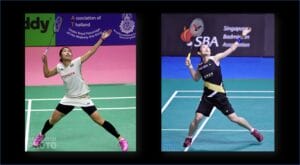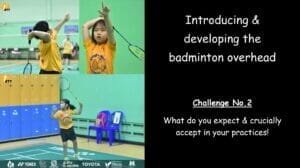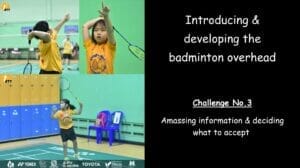Introducing the badminton overhead to novice players
Developing the overhead forehand is a critical task
Especially with young beginner players in the first few months
It’s very easy for players to discover inappropriate techniques 🙁
What do you see when players try to discover their ‘best’ overhead technique?
The challenge for coaches is how to provide the best start
and how to prevent those future limiting techniques
5 challenges
If you work with beginner players to develop a badminton overhead forehand and have experienced challenges this information is for you. I want to help, challenge and give you some ideas.
Come and take a look at some of these challenges. Those that apply specifically during the first few months when working with young novice players. The badminton overhead is critical and full of potential issues, so let’s explore them 🙂
Over the next few posts, I’ll provide information for each of the 5 challenges that most coaches will face. Each will give you some detail about the challenge and plenty to think about, plus ideas to try.
Maybe you will have already encountered some or have information to share about how you’ve mastered them! If you have, I’d really like to hear your thoughts 🙂
– – – – – – – – – – – – – – – – – –
Click each one to read more
· The challenges – will you agree?
· Coaches with different opinions
· How to use this information
. Read lots more about the 5 challenges
– – – – – – – – – – – – – – – –
The challenges
Do you agree that the badminton overhead forehand is one of the most important strokes?
Overhead strokes produced, rally-ending strokes, either with outright winners or by forcing your opponent to make an error. Players need the best start or introduction to this complex moment.
However, this movement also attracts the most coaching problems or challenges (in my opinion), maybe even more than an overhead backhand.
These challenges are varied and the driver (the reason) for each can be very different. Some result from the practice design, others from the players’ motivation to be ‘successful’, and some from the way young people develop and learn.
I’ve picked 5 challenges but you may have others, I’m sure of that!
What are these challenges, how different are they, and crucially why is it important to be aware of them.
How many of these issues do you recognise?
- Ineffective and future limiting techniques – there are many of these, but what’s a good plan to reduce the chance of them developing?
- How to increase the level of immediate success – missing or miss hitting can be the majority of attempts in novice players 🙁
- The problems with Self-discovery (organisation) – when left alone players often revert to ineffective techniques as a means to be ‘successful’
- Varying levels of player & coach motivation – the expectation and reality of developing an overhead can be challenging
- Ineffective use of practice time – progression can be slow. Could there be other practice types and situations that would be more productive, yet still help overheads?
If you coach overheads as one of the early strokes, do you see these challenges?
Here are 5 challenges for you to consider
(links to each at the bottom of this post, or click on each to jump into the post)
- Challenge No. 1 – how to create a plan and what to include?
- Challenge No. 2 – what do you expect & crucially accept!
- Challenge No. 3 – amassing information & deciding what to accept
- Challenge No. 4 – how to transfer the critical information you know
- Challenge No. 5 – how much movement to include at the start
– – – – – – – – – – – – – – – –
Coaches with different opinions
After talking with two coaching friends it was apparent that we all recognised these 5 challenges, plus a few more. Although one of us hadn’t thought about no.5 and was unsure about it.
We certainly had different approaches to how an overhead forehand technique could be developed. Not the technical content but the methods that we would use in those first critical 5 – 12 months when working with novice (beginner) players.
One of us used lots of varied methods (practices), the others preferred to stay with a small set of repeatable practices 🙂

When we discussed the individual technical elements, the differences were not that great, we agreed on the vast majority. Our list of the core must’ haves was very similar’
We even agreed on many of the different practices we’d use. However, alternative viewpoints did start to appear.
The differences grew bigger as we discussed when to introduce these technical aspects. How did we decide when to use the different practices and why did we make those choices. The more we chatted about the things we agreed on (or thought we did) the more we found differences.
It was a strange conversation 🙂
Then we established the biggest differences
Difference No.1 : what to start with
- One of us had the opinion that themes/practices/coaching should focus on ‘below & around shoulder’ strokes, before concentrating on overhead work.
- They seemed certain that some essential skills could be partly developed before overhead work, and that would help the development of overhead striking.
- The other coaches disagreed and believed that overhead work could start early alongside all other strokes
- As it was an important stroke they believed it should be started early, even if there were lots of mistakes that they knew would happen – see challenge No.2
Difference No.2 : developing trust in the coach and the practice
- One of us felt strongly that a ‘trust in coach & process’ should be developed from the early stages. They explained that it was their term for the confidence that players had in the coaching they received and experienced.
- It allowed them to face challenges and experience failure knowing that the practice (challenge level) that was set by the coach would lead towards success (in its various forms)
- The other coaches understood the point being made but didn’t see the value in deliberately changing and adjusting the practice (challenge level). They were confident that the standard ‘classic’ practices they used would lead to success.
- They also felt that it was important that players understood that some things were difficult before they became easy. They felt that ‘constantly’ changing the practice and challenge level was a form of ‘over coaching’
We differed less about ‘what’ to practice
BUT
We significantly differed over the ‘when & how’ to practice
– – – – – – – – – – – – – – – –
How to use this information
Deciding when to implement a particular practice or emphases certain aspects is critical
I hope to prickle your thoughts and beliefs 🙂
My desire is that you will consider the discussion points and challenges, I hope you have time to do that. The ideas and suggestions listed here are my best advice at this time. It’s up to you to decide what to take, use, and maybe reject.
Please do not assume that every statement or bullet point listed is essential or has an equal weighting. Some are ‘could haves’ and others are essential ‘must haves’
You will acquire lots of information about the badminton overhead forehand as there certainly isn’t a shortage of people stating the technical elements they believe need to be included – me included 🙂
However, there isn’t as much information about when or how to practice in a long-term structured way starting from the first few months
Often the timing of the coach action is more important than what is done by the player
This is the ‘hidden’ coaching skill.
– – – – – – – – – – – – – – – –
The challenges: click each image to read more
Challenge No.1 – how to create a plan and what to include?
You need a plan for those first crucial 6 months, and maybe for the next year. But what would you include and why?
This post examines the challenge of putting together a plan, especially when working with young players who are new to the sport. It’s very easy to develop what seems like an effective technique but in fact, it’s probably a ‘future limiting’ technique. Maybe even techniques that could lead to injury.
This advice may surprise you
Challenge No. 2 – what to expect & crucially accept!
Imagine starting to coach overhead forehands with beginner players, what would you expect to happen in the practice? Could you write a list of the 4 or 5 things you would expect to happen?
The things coaches expect and crucially accept!
It concerns me that coaches expect issues/problems to occur when starting to coach overhead. They then accept the situation but don’t plan to avoid the aspects they have continually experienced.
Challenge No. 3 – amassing information & deciding what to use
As coaches gain experience they will acquire lots of information, I’m sure we all do that. Everyone I’ve met will give you advice or ‘great’ practice that you could try.
I’m certainly an avid collector of information! 🙂 But where I begin to feel uncertain is in deciding what filters if any I should apply to new information.
Why is it that everyone has a magic bullet of a practice, to help with the badminton overhead forehand? I have a bag full of these nearly perfect ‘magic bullets’ and only some work some of the time. 🙂
Challenge No. 4 – how to transfer critical information
Do you believe that young beginner players ‘need to know what you know’, the technical aspcts?
I’m suggesting that the coach’s desire to transfer information to young players is not an effective coaching strategy. Especially not if the information is content from the manual you use!
The key is deciding what information is important, BUT then deciding how to ‘package’ this for the players to experience, hear and see. It may take much longer than you initially want to accept, but you will have to do less ‘reminding’ of players
Challenge No. 5 – starting with the complete movement, is that best?
This may be the most challenging part of this post for you to accept!
Could you be limiting the effectiveness of your coaching by encouraging the whole movement and linking movements when introducing the badminton overhead forehand.
However, reducing movements can also cause issues. I want you to consider how much movement is just enough.









